Adding Applications
To add applications, use the Add Applications Wizard. Pop-up prompts enable you to launch the wizard as you log in to new Windows, Web, Advanced Web, or Java applications, or you can manually launch the wizard.
The Add Applications Wizard helps you generate login scripts and store variables (for example, usernames and passwords). The Wizard captures login data to use in SecureLogin prebuilt scripts or creates new scripts for Windows, Web, and Java applications.
The wizard-generated login scripts store your login name, password, and any other information required for authentication. Scripts are stored in the local database and in the directory. The wizard is only available from the workstation. It isn't available in the SecureLogin snap-in to ConsoleOne® or in Active Directory Users and Computers.
Responding to Pop-Up prompts
After SecureLogin is installed on your desktop, SecureLogin watches for applications that aren't enabled for single sign-on. Upon detecting such an application, SecureLogin prompts you to use SecureLogin wizards that enable those applications for single sign-on and thereby simplify future logins.
Prompts for Windows Applications
After detecting a Windows login panel, SecureLogin displays the following dialog box. (If the application has a prebuilt script, the initial text varies.)
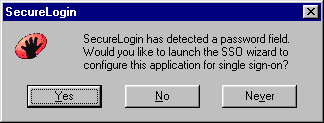
You can choose not to enable single sign-on for this application. If you select to not be prompted during future encounters, SecureLogin generates a blank script for this application and doesn't prompt you again.
If you click Yes, SecureLogin launches the Add Applications wizard, which guides you through the setup and creates a script for the login panel. The next time you open the application, SecureLogin authenticates for you.
Prompts for Web Pages
When you navigate to a Web page that has a login field and then submit your login information, SecureLogin prompts you whether to enable single sign-on for the site, for only the current page, or not at all.

If you click Yes, SecureLogin extracts the login information from the Web page and stores it for future single sign-on authentication.
Save for All Pages at This Web Site |
Saves the script against the base URL of the page (for example, mail.yahoo.com). |
Save for Only This Page |
Saves the script against the exact URL of the page (for example, http://login.yahoo.com/config/mail?.intl=au). |
Yes |
Creates a script, automatically reads the credentials entered into the browser, and stores the credentials against suitable variables. The next time the Web page is loaded, SecureLogin enters your credentials. |
No |
Doesn't create a script. The next time the Web page is loaded, SecureLogin displays the prompt again. |
Never |
Creates a blank script with no variables. The next time the Web page is loaded, you aren't automatically logged in or prompted to enable the Web page for single sign-on. |
Details |
Changes the URL that is saved with the script. Select a URL suggestion from the drop-down list or enter a URL. See the following figure. |
Prompts for Applications That Have Prebuilt Scripts
When SecureLogin detects a login panel for an application that has a prebuilt script, SecureLogin prompts you with the option to implement that script. The following figure illustrates a prompt for a Web site:

To enable the script, click Yes, then enter the required credentials. SecureLogin logs you into the application whenever the application is launched.
To ignore the prompt, click No. The next time SecureLogin detects the application's login panel, SecureLogin displays this prompt again.
Manually Adding Applications
If the Add Application Wizard doesn't run automatically, you can launch it:
-
Right-click the system tray icon.
-
Click Add Applications.
You can also click Start > Programs > Novell SecureLogin > Novell SecureLogin > Applications.
-
At the Welcome dialog box, click Next.
-
Add an application that has a prebuilt script, add a Web application, or add a Windows application.
Using Prebuilt Scripts
Scripts store certain login information so that it can be used again and again. To save you the time and trouble of setting up scripts, SecureLogin provides prebuilt scripts for many applications.
To add an application that has a prebuilt script:
-
Right-click the SecureLogin icon on the system tray, then click Add Applications.
-
At the Welcome window, click Next.
-
Click Prebuilt Scripts, then click Next.
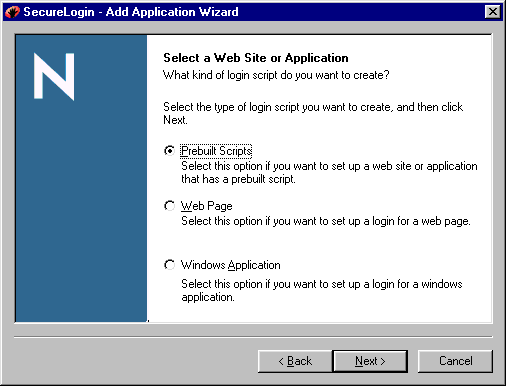
-
Select the application from the list, then click Finish.
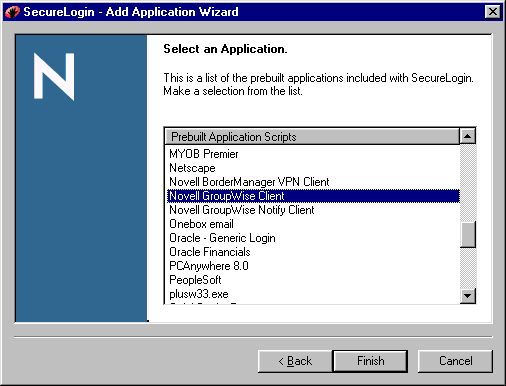
-
Provide a login.
As the following figure illustrates, when you next launch the application, SecureLogin prompts you to enter login variables.
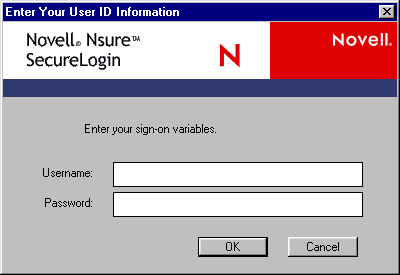
After you type the variables and click OK, SecureLogin saves this data and logs you in. For subsequent launches, SecureLogin automatically logs you in.
You can also provide login data manually:
-
Right-click the SecureLogin icon on the system tray, then click Manage Logins.
-
Click User IDs > New.

-
Type a description for the user ID, then click OK.

Typically, enter the application name.
-
Type login variables.
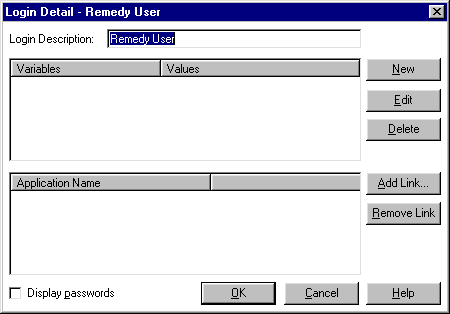
Entering a Name in the Variables Column
To enter a name in the Variables column, click New, type a name (for example, Username), then click OK.

"Username" is a typical entry. However, it's a good idea to use the text that appears on the login panel. For example, text for a Windows application might be User Name or User ID, but text for a Web page that logs you in to a bank might be Account.
Entering a Value
The entry in the Variables column requires a matching value. In the Editing Username dialog box, type the value (for example, the actual username), then click OK.

Add other variables (for example, Password) and matching values (for example, the actual password) as required in the login panel.
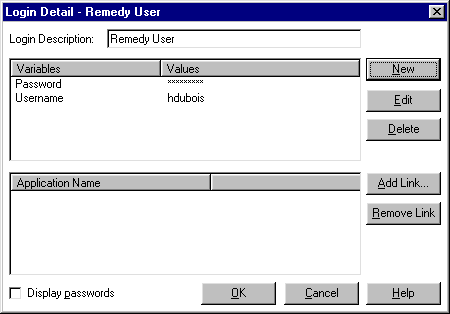
If you have already saved values, you can edit them. For example, to change a password, click the Password variable, click Edit, then type and confirm the new password.
Save the variables and values for the login by clicking OK, then save the data to cache by clicking OK.
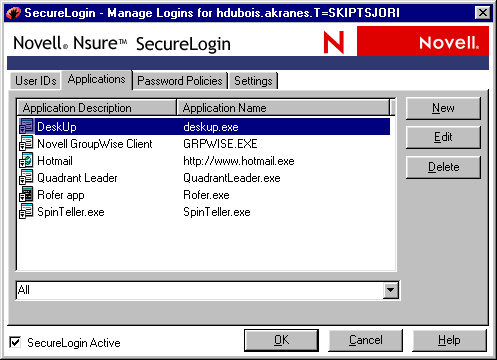
Adding a Windows Application
The following steps apply when SecureLogin doesn't automatically detect a new application. If SecureLogin detects a new application and launches the Add Application Wizard, go to Step 6. For information on SecureLogin's pop-up prompt, see Responding to Pop-Up prompts.
-
Launch the application and drag the login panel to one side of the screen.
-
Type login information (for example, username and password), but don't click OK, Next, or Finish.
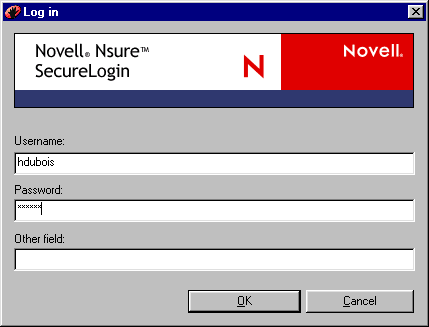
The login panel needs to remain so that SecureLogin can capture the information on the panel.
-
Right-click the SecureLogin icon on the system tray, then click Add Applications.
-
Click Next > Windows Application > Next.
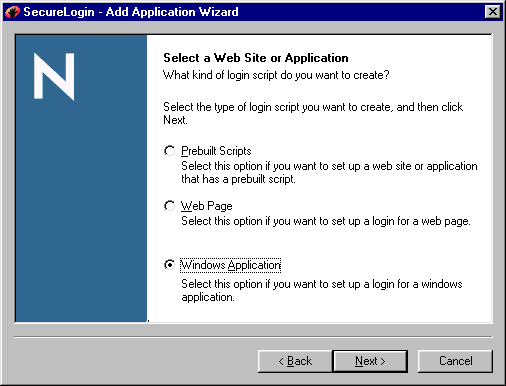
-
At the Set Up a Windows Application window, drag the hand to the title bar.
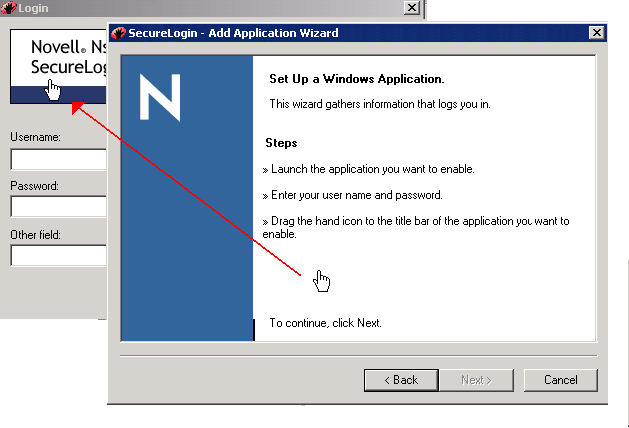
-
At the Select Window Function window, select Login Window from the drop-down list, then click Next.
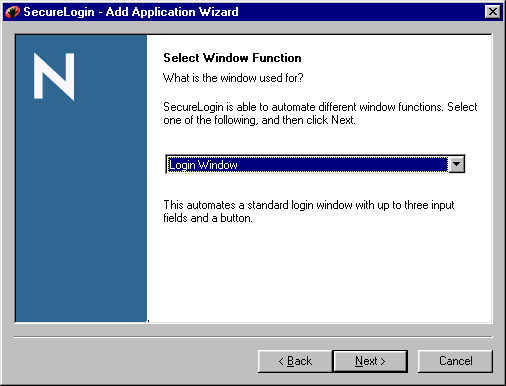
-
Select the login fields.
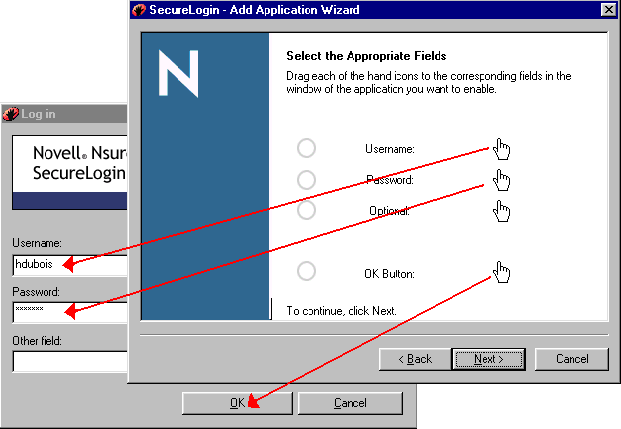
-
Drag the hand icons and drop them onto the corresponding Username, Password, and (if appropriate) Optional fields on the login panel.
-
Drag the hand icon for the OK Button and drop it onto the OK, Next, Continue, or similar button.
-
Click Next.
-
At the Confirm Details dialog box, verify that your username is correct and that a password exists, then click Next.
-
At the Name the Script window, accept the default name (or select a name from the drop-down list or type a new name) for the application, then click Finish.
Adding a Web Application
-
From a browser, go to the URL of the Web page that you want to log in to.
-
Right-click the SecureLogin icon on the system tray, then click Add Applications.
-
Click Next > Web Page > Next.
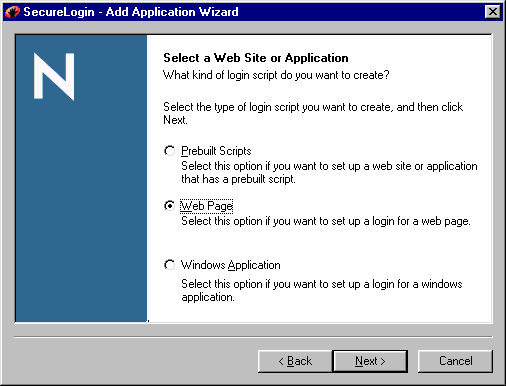
-
At the Set Up a Web Page dialog box, copy and paste the URL, type your username and password, then click Finish.
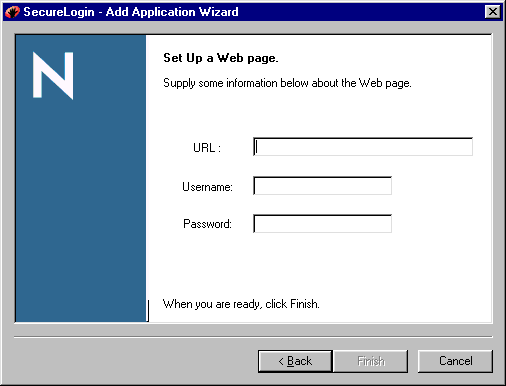
If you have difficulty logging in to a Web site, see Why is SecureLogin unable to log me in to some Web sites?.
Adding a Java Application
Prerequisites
- Sun Microsystems Java Runtime Environment (JRE) 1.4.2 or later is installed on the workstation.
- Following installation of the JRE, SecureLogin 3.51 is installed on the workstation.
- You have advanced knowledge of scripting.
Enabling the Add Applications Wizard for Java
When the JRE is installed, the SecureLogin installation program installs Java support by default. However, when SecureLogin first launches, the Add Application Wizard for Java is disabled. To use Java applications, you must enable the Add Applications Wizard for Java.
-
Right-click the SecureLogin icon on the system tray, select Manage Logins, then click Settings.
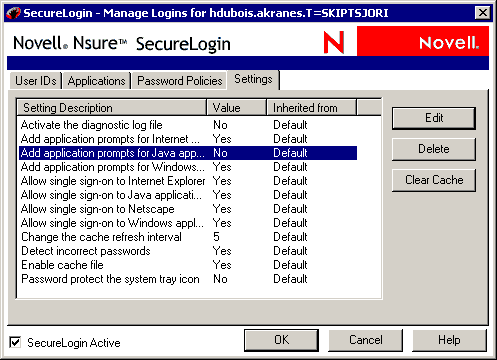
-
Select Add Application Prompts for Java Applications, then click Edit.
-
Change the value to Yes, then click OK.
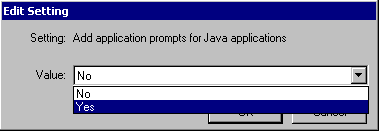
-
Save the data by clicking OK.
Adding the Java Application to the List of Applications
-
Launch the Java application.
The Java application can be an applet or an executable file.
SecureLogin displays the following message:
Java SSO has detected a new platform. Would you like to generate a script for it?
NOTE: The script will only contain the list of controls in this Java program. It will need to be modified to achieve full functionality.
-
(Conditional) If the dialog box that appears isn't the one that you want SecureLogin to learn for the Java application, click No.
-
Navigate to the dialog box that you want SecureLogin to learn, then click Yes.
Multiple instances of the "Java SSO" message appear for every instantiation of the Java application.
-
Close the application.
-
On the Setting tab, set the Add Application Prompts for Java Applications to No, then save the data.
-
Verify that the application has been added.
View the applications listed on the Applications page. SecureLogin displays a new icon and application type.
However, the user IDs are blank and several lines in the Description column are commented out. The number of lines depends on the application.
Also, the number of control boxes (edit, OK, Cancel) depends on the application. For example, an application might have three edit boxes. Control #1 might be the Username field, defined with its Java class. Control #2 might be the Password field, with its Java class. Control #3 might be an Other field, also defined by its Java class. The control numbers might be as follows:
Edit box 1 |
Username field, defined with its Java class |
1 |
Edit box 2 |
Password field, defined with its Java class |
2 |
Edit box 3 |
Other field, defined with its Java class |
3 |
Button |
OK |
4 |
Button |
Cancel |
5 |
-
Provide a script for the Java application.
To provide a script for a Java application, you need advanced scripting knowledge. We recommend that a consultant help you with advanced Java applications.
A basic script follows:
Dialog
Type $Password
Type Control #2
Type $Username
Type Control #1
Type Control #3
Delay 1000
Click #1
EndDialog
Many Java applications require a Delay command, so that user ID information can be entered before the OK button is clicked. This scripts types the password, types the username, types the Other field, waits 1,000 milliseconds, moves the mouse to the OK button, then clicks the OK button.
With Java applications, Raw submits (as found in scripts for Windows and Web applications) are not supported.
-
Launch the Java application, then enter user information.
SecureLogin collects the information that you enter, executes, and logs you in.





















